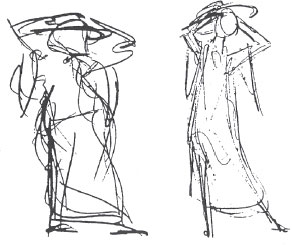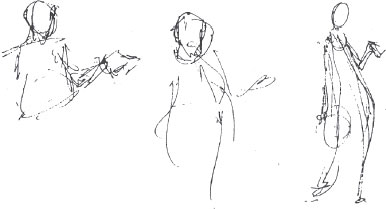Don Graham, that great teacher of drawing and painting, who was so instrumental in getting the Disney style of animation off and running, said an animation drawing is a “storytelling drawing.” That thought should be uppermost in our minds whenever we are drawing from a model or animating. For the sake of clarifying that thought and to drive the point home (make it your own), let me quote further from Don Graham’s book, The Art of Animation:
The extreme, the important drawing of every action, represents the outside limit of an action or a gesture. It indicates at what point the direction of an action changes. If an arm swings backward, at some point it must swing forward. The extreme also represents a momentary pause, or rest, in the action. A bouncing ball, at the point of contact, or at the height of the bounce, seems to be stationary.
At about the time of the Three Pigs this pause in the action suggested a new use of the extreme. Instead of being just a turning point, or a rest point in the action, it now became a drawing of great and special picture interest, a storytelling drawing. By making this drawing more expressive and by having it suggest what was about to happen or what had already happened, the intervening action could be suggested, rather than delineated, to an unbelievable degree.
Watching straight-ahead animation is like watching a buzzard or a hawk wheeling and gliding in the sky. The action is continuous but monotonous because we see a series of poses of equal interest. Watching animation is like watching a hummingbird darting from flower to flower. The action is continuous but exciting because we are able to see separate poses which are made possible by definite rest periods in the action.
That is by no means a complete formula for animation, it was only quoted to stimulate you into thinking that whenever you are drawing you are drawing a storytelling drawing. The mere thought should help to focus your attention on the purpose at hand — at that very crucial moment when all the elements of your drawing converge. This is when the right side of the brain assembles all the left brain’s research and creates a “storytelling drawing.” Supposedly the left brain has done its work. You have studied anatomy, cartooning, perspective, composition, acting, and pantomime. Now it is all brought together in one electrifying moment of unification — when a storytelling drawing is brought to life. I see it happening every night in our drawing class. Here are some examples of bringing all that hard earned knowledge and sensitivity together. These are Joe Ranft’s drawings of mime, dancer, storyteller Judith Harding and Alex Topete’s drawings of former dancer, actress Lalla Lezli. If I were to try to tell you how nice these drawings are, and how close they come to describing the storytelling genius of these two models — you would be turned off by my “gushiness.” I’ll let the drawings speak for themselves.

Of course sometimes work takes its toll, or we can’t gather our thoughts together, or our biorhythms are nose-diving, so I have to intervene with the “magic formula.” Here are a few examples. Oh, incidentally, and this is important, if some of these drawings look bad, it’s not because the artist is bad — it’s because the concept of the gesture was not fully comprehended or energized. When the concept is clear it suggests and inspires ways of drawing it well.
Here is a drawing that you can see the artist lost all interest in. If he had gotten a better concept of it I’m sure he’d have pulled it off.

Here is a similar problem, and as you can see I interrupted the artist at an early stage, and suggested he introduce some opposition, which is what the model was doing anyway — the head angled in one direction the torso in another, and the legs in still another. It’s not an invention of mine. It’s a very natural gesture. Stand up and try it.

Here is a case where an important storytelling aspect got overlooked. If the artist had rehearsed the story in his mind — she is leaning on her elbows, cogitating — he’d have no doubt made her “lean.” Bending her forward puts some weight on the elbows and says, “lean.”

In this last one Lalla was selling flowers. In the artist’s version, she doesn’t seem to be making any appeal to a possible buyer. To get someone’s attention and make an appeal, universal body language requires that you lean toward the person. This intensifies the eye contact, in the hope of making a more sure contact, arousing interest, or even pity.


